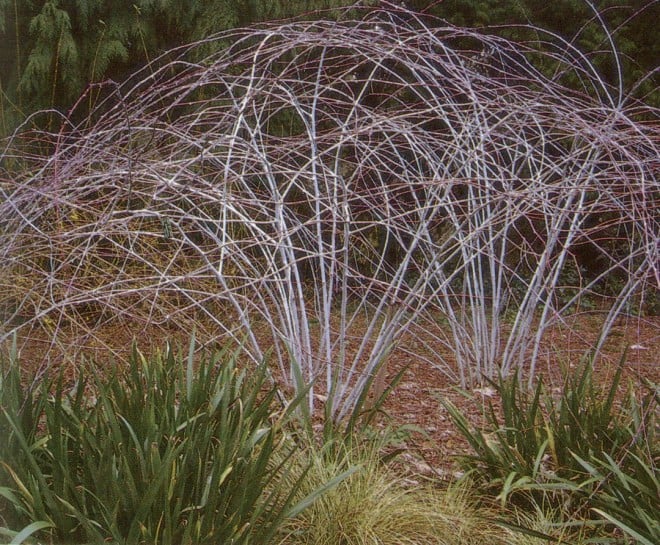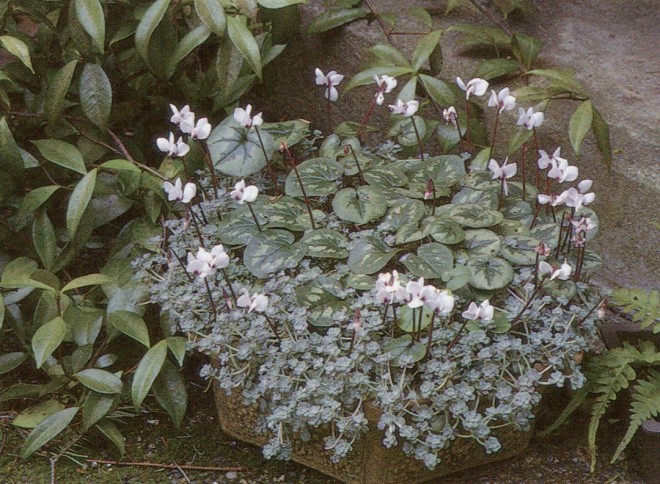

Contributor
- Topics: Archive, Inspired Gardens and Design
Winter colour is nature’s most sophisticated palette–a range dominated by subtle tones, sombre contrasts and striking highlights. For the winter gardener, the challenge is to enhance and build upon this mellow array.
Rosemary Verey, The Garden in Winter
In the best years, Northwest gardens reach their peak in September when a patchwork of saturated red, bronze, and gold is flung across the autumn landscape. At close range, sunflowers, asters, and colchicums insist on entertaining us, even as fall chores demand attention. We revel in the warmth of the year’s fleeting sunshine, knowing that short days, with time for pondering, lie just ahead.
Fall gardening is strenuous—a perfect time to plant the homeless shrub, divide Pacific coast iris, and add a bucket of bulbs to the newest bed. When November’s rains become relentless, and the chill has settled in bone and stem alike, it is tempting to run for cover and spend the winter admiring the shapes of trees and the colorful feathers visiting the kitchen window’s bird feeder. For some, short winter days can make a stroll in the garden a rare event, but for other Northwest gardeners, the subtle beauty of winter is just as alluring as the opulence of flashier seasons. In fact, some of these intrepid folks go to great lengths to plan their gardens for winter enjoyment.
One such character was Edward B Dunn, whose energy and enthusiasm for Northwest plants and rhododendrons are still visible in the EB Dunn Woodland Garden in North Seattle. Developed between 1947 and 1991, Dunn’s woodland reflects his lust for flowering plants, including magnolias, dogwoods, trilliums and erythroniums—all planted in the shadows provided by a canopy of firs, chestnuts, and maples.
First designed for Dunn’s father, Arthur, by the Olmsted brothers in 1915, the gardens are now supported by the EB Dunn Historic Garden Trust, and managed by curators Glenn Withey and Charles Price. Dunn grew cyclamen and species rhododendrons from seed, filling his woodland with Rhododendron mucronulatum, Daphne laureola, and Camellia x williamsii. The now mature specimens of Magnolia sargentiana var. robusta and M. campbellii that he planted would be enough legacy to make any gardener proud. Price and Withey have continued Dunn’s focus on choice plants for winter interest by including an extraordinary collection of hellebores and three specimens of Acer pensylvanicum ‘Erythrocladum’, a tree that sports red-striped winter bark. The result is an enviable winter scene.

Garthwaite/Sullivan Garden
Horticultural lust and admiration inevitably creep into one’s consciousness while wandering through the serene one-and-a-half acre woodland garden of Bobbie Garthwaite and Joe Sullivan. Garthwaite and Sullivan have, over many years, carefully replaced the garden’s aging rhododendrons and fallen giants with a variety of choice trees and shrubs, such as Viburnum bodnantense ‘Dawn’, Magnolia wilsonii, witch hazels (Hamamelis), and winterhazels (Corylopsis).
The garden’s most prominent winter feature is the rushing stream that creates an unexpected, reflective intimacy. Its mossy banks invite close observation and repay the wanderer’s attentiveness with patches of blue and yellow crocus and an occasional, sunny Narcissus cyclamineus. The stream is traversed by a narrow bridge paved in stepping stones with spaces left for small plants; it was created by George Little and David Lewis of Little and Lewis Water Gardens, also located on Bainbridge Island.
Unusual groundcovers also provide interest for the slowly strolling visitor. The small, scattered, heart-shaped leaves of false lily-of-the-valley (Maianthemum bifolium), blends cheerfully with Pachyphragma macrophylla, a crucifer that, in addition to bright green foliage, offers its small, upright, white flowers for much of the winter. Joe’s extraordinary stonework is the ideal complement to the moss and water. Small groups of almost perfectly round stones highlight the beauty of an ancient stump; another grouping draws the visitor to linger over a quiet patch of mossy ground. The contemplativeness of the season allows time to appreciate the sounds of water and wildlife and the intermingled textures of plants and rockery; each small snowdrop or primrose blossom seems significant.

Blumenthal/Edsforth Garden
Even if you’ve less than an acre, you can still enjoy the beauty of a winter garden. In urban Seattle, Jabe Blumenthal and Julie Edsforth walk daily through their small entrance garden, designed by Madelyn Katzman and Bob Lilly. The garden perfectly suits the Tudor architecture of their home. The trunks of the three Himalayan birches (Betula utilis var. jacquemontii) that grace the parking strip elegantly acknowledge the white stucco of the house, while the winter bark of the coral bark maple (Acer palmatum ‘Sango-kaku’) and the leaves and flowers of Euphorbia amygdaloides ‘Rubra’ echo the home’s deep-red brick. Details matter here, too: the bits of red found in the dried Japanese blood grass (Imperata cylindrica ‘Rubra’) and on the edges of the flowers of the apple-green Helleborus foetidus surprisingly reappear in the small red-flecked, cream bells of Clematis cirrhosa that twines through a large Hinoki cypress (Chamaecyparis obtusa).
In this garden, texture and contrast is as important as the color that arises from the myriad plants specifically chosen for winter interest. The dark green foliage of juniper, which so thoroughly absorbs light, is combined with the blue-gray twigginess of two large, upright shrubs of rosemary (Rosemarinus officinalis ‘Arp’) that flank the front steps; decidedly different textures come from shiny, reflective camellia leaves, a columnar holly (Ilex ‘Sky Pencil’), and rustling dried grasses. Additional excitement is provided by the blossoms of early red rhododendrons—old Blumenthal family plants moved here during the garden’s construction—and the fragrant blooms of Daphne odora ‘Aureomarginata’ and Sarcococca hookeriana var. humilis. This garden looks good year-round and surely must lift the spirits of every neighbor out for a winter walk.
JA Witt Winter Garden

The challenge of choosing plants to incorporate into a Northwest winter garden has become much easier since the creation of the JA Witt Winter Garden at Seattle’s Washington Park Arboretum. Designed in 1988, the garden offers the bundled-up public a quiet stroll where winter-blooming plants can be viewed at their best. A January or February visit to this garden gem is likely to reveal a wealth of horticultural possibilities, including several selections of spidery-flowered witch-hazel (Hamamelis). The almost naked branches of H. x intermedia ‘Pallida’ are saved from embarrassment by a plethora of strategically placed, pale yellow floral tufts; H. x intermedia ‘Orange Beauty’ is similarly clothed in stars of orangy-bronze. And the remarkable Cornelian cherry (Cornus mas) stands out as a cloud of breathtaking sunshine.

The dramatic hybrid silk tassel bush (Garrya x issaquahensis), found by chance in an Issaquah garden, captures the eye with its eight-inch long flower tassels and soft green leathery leaves. Lingering scent is provided by the small, pale pink blooms of Daphne odora and by sweet box (Sarcococca confusa). For both fragrance and blossom, it is hard to ignore the many selections of Camellia sasanqua. With pink, red, or white blooms, these versatile shrubs have smaller leaves than the more frequently encountered, later-blooming selections of Camellia japonica. Occasionally vulnerable to an unexpected, early freeze, in most Northwest winters the sasanquas flowers from November through January and can be trellised or pruned into a low hedge.
The most surprising color in the larger landscape is found in the Witt Garden’s mass plantings of shrubby dogwoods whose bare stems are striking yellow (Cornus stolonifera ‘Flaviramea’) or bright red (Cornus alba ‘Sibirica’), and in a large group of silvery white, ghostly brambles (Rubus biflorus var. quinqueflorus).

A winter garden can be of any size. It may be no more than a single, small container of Cyclamen coum ‘Album’ and Sedum spathulifolium ‘Cape Blanco’, as created by Withey and Price; placed to stop Dunn Garden visitors in their tracks, it demands close attention to the satisfying relationship between the cyclamen’s white-winged petals and intricately netted green leaves, and the sedum’s silvery rosettes. Or it may be an entire 230-acre arboretum, awaiting discovery by visitors in hats and mittens. The short days of winter bless gardeners with time for introspection and renewal—the chance to contemplate life with reawakened astonishment, and the opportunity to, once again, feel both the breadth of landscape and the perfection of its smallest detail.
Richard Hartlage’s A Garden Sanctuary (Summer ’99), with more fine photography by Lynne Harrison, featured Terry Welch’s Woodinville garden, which is rich is ideas for making the most of winter in a Northwest garden.
Share:
Social Media
Garden Futurist Podcast
Most Popular
Videos
Topics
Related Posts

Ground Up Science for Greener Cities with Garden Futurist Dr. Alessandro Ossola
Spring 2023 Listen to the Podcast here. Alessandro Ossola is a scientist who gets very excited about the challenge of climate change allowing for an

Readying Urban Forests for Climate Realities with Garden Futurist Dr. Greg McPherson
Winter 2023 Listen to the Podcast here. “Going from the mow and blow to a more horticulturally knowledgeable approach to maintaining the landscape. And that

Low Maintenance Gardens – Better for Pollinators and People
Autumn 2022 “I come out every day. It’s therapy, my meditation.” Janet’s young garden transformed from overgrown, invasive plants to mostly natives. The dailiness of

Calochortophilia: A Californian’s Love Affair with a Genus
Summer 2022 I can chart the progression of my life by Calochortus. For the last two decades, at least. As a teenage girl growing up








Responses